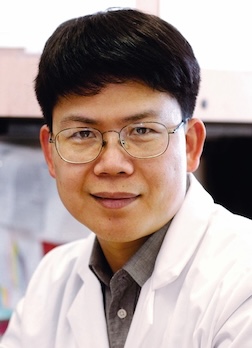The Dark Side of DNA: How the Immune System Senses DNA as a Danger Signal
to

Zhijian "James" Chen, Ph.D.
George L. MacGregor Distinguished Chair in Biomedical Science; Director of the Inflammation Research Center; Professor of Molecular Biology; HHMI Investigator
University of Texas Southwestern Medical Center
Zhijian “James” Chen’s research into complex cellular biochemistry has led to the discovery of pathways and proteins that trigger immune and stress responses. Chen has identified proteins, such as the mitochondrial protein MAVS, that are crucial to the body’s defense against RNA viruses such as influenza and Ebola. Now, Chen and his team are dissecting a signaling pathway involving a novel DNA sensor – cyclic GMP-AMP (cGAMP) synthase, or cGAS – which activates an interferon response that may play a role in immune defense against pathogens and malignant cells, as well as in autoimmune diseases such as lupus. Treatment of these autoimmune diseases could involve chemical inhibition of cGAS, whereas cGAMP and its derivatives may be used as adjuvants for vaccines and cancer immunotherapies.
Summary
https://videocast.nih.gov/watch=51169
DNA entering the cytoplasm of mammalian cells is a danger signal that triggers a potent innate immune response, including the production of type-I interferons and inflammatory cytokines. We have identified the enzyme cGAS as the sensor of cytosolic DNA that triggers the innate immune response. cGAS catalyzes the conversion of GTP and ATP into cyclic GMP-AMP (cGAMP), which functions as a second messenger that activates the adaptor protein STING and the downstream pathway. The cGAS-STING pathway plays a critical role in immune defense, cellular senescence, autoimmune diseases and cancer. As such, this pathway must be tightly regulated. I will discuss our work on the regulation of the cGAS-STING pathway in animal cells. In addition, I will report on our recent findings on the role of bacterial cGAS in anti-phage immune defense.
Presentation Objectives:
- To understand how cGAS senses DNA to trigger an innate immune response
- To understand the mechanism of signaling in the cGAS-STING pathway
- To understand the evolutionary origin of the cGAS pathway and how it defends bacteria from phage infection
This page was last updated on Wednesday, October 11, 2023